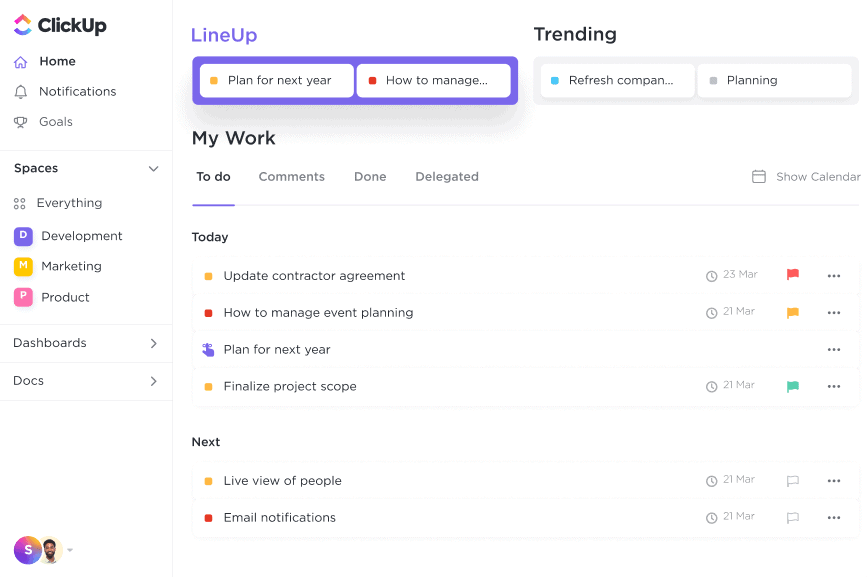
Project management software enables enterprise project teams to visualize each step of their project, including tasks that must be completed and overall project roadmaps. It helps the individuals responsible for each task manage their schedule and communicate with other project stakeholders.
Asana and ClickUp are two major project management tools that give project teams task management, documentation, and collaboration features. Asana and ClickUp both serve businesses of all sizes, including startups, and offer plenty of tools for task tracking. To determine which PM tool is right for your business, consider your organization’s specific needs when comparing ClickUp and Asana based on task management, user experience, customizability, and pricing.
What is Asana?
Asana is both project-focused and user-focused.There are plenty of features for users to track their personal progress, like viewing workloads and portfolios, which are collections of multiple projects. Asana offers a free plan with extensive features and is particularly suitable for smaller businesses and startups, particularly those that don’t have many employees experienced with project management tools.
What is ClickUp?
ClickUp, known as “the one app to replace them all,” is intended to serve as multiple business applications in one, including documentation, communication, and calendar tools.
It has features tailored to multiple departments—for example, product roadmaps, marketing campaign management, and new hire tracking. Product teams can customize each step of a roadmap, marketers have A/B testing templates to track campaign progress, and HR teams can use onboarding templates to manage new employees’ progress.
Because it’s customizable and offers department-specific task design, ClickUp is suitable for businesses in a wide range of industries.
Asana vs. ClickUp: Task management
Asana supports the waterfall approach to project management because its tasks support dependencies, which require another task to be completed before beginning the next one. It also supports agile projects with Kanban board layouts, which allow users to drag and drop tasks between stages, including dragging them to a previous stage if they need to be revised.
Asana users can view status changes on other tasks within their projects. They have four different options for project views: list, board, calendar, and timeline. With options for multiple views, team members are able to use the task visualization format that works best for them. Employees aren’t stuck in a task view that they don’t understand, which gives more flexibility to the whole team.
Where ClickUp shines is its features for task management. Users can build custom statuses for tasks based on those tasks’ operations. For example, a content team might want to set statuses for article drafts to be reviewed, while a dev team might need statuses for checking code and deploying it. Custom statuses allow users to design project-specific process checkpoints.
ClickUp users can also set dependencies for tasks. If one department uses the waterfall methodology for project management, they’re able to tie one task to another. This helps teams to mark and visualize the relationships between tasks.
Also read: Best Agile Project Management Tools
Asana vs. ClickUp: User Experience
Multiple business reviewers found that the interface was intuitive and easy to use—it just may take time to understand for users who don’t have experience with project management tools. For extremely inexperienced PM software users, Asana may be difficult to learn to navigate. Some users also mentioned that they receive frequent email notifications from Asana, which can clutter the inbox.
Some Asana integrations include Zoom, HubSpot, Slack, and Gmail. Project and task updates can be configured to automatically populate a Slack channel, which speeds the communication process for team members who use Slack more regularly than Asana.
Multiple user reviews said that ClickUp sometimes lags; also, while the ClickUp team regularly adds new features, this can result in bugs. Including more functionality in your instance of ClickUp may require more time for users to grow accustomed to the features. ClickUp demo videos are available for customers to study different sections of the software.
Notable ClickUp integrations include Slack, Google Drive, Apple Calendar, and GitHub. If your project teams use GitHub repositories regularly, consider ClickUp—developers are able to view commits and merges from code repositories within their ClickUp tasks.
Both Asana and ClickUp offer mobile applications that support Android and iOS. Teams that need to manage projects on the go or outside traditional office spaces will benefit from mobile access to tasks.
Asana vs. ClickUp: Customizability
Asana allows multiple views, and different users can choose which one works best. It supports agile projects with features like Kanban boards.
Asana also offers project templates that are categorized based on department activities. Asana’s wide range of templates allow different departments to customize their projects based on their specific operations. These include:
- An editorial calendar. Content teams can track their writing and production with statuses customized for publishing.
- Account tracking sheets. Finance departments can use Asana to manage accounts and tag team members on specific items.
- Engineering product roadmaps. Engineering managers can create a roadmap and present it to their teams and to business leaders, receiving approval or commentary on each stage of the project.
Multiple users pointed to ClickUp’s customizability. Because it’s designed to replace other business apps, it’s a multipurpose tool for communication, dashboard reporting, and collaboration.
ClickApps are applications within ClickUp that provide additional functionality for users, such as screen recordings that can be shared to ClickUp tasks and custom fields within tasks. These apps allow users to further customize their tasks based on the work style that’s most convenient for them and improve visibility for the rest of their coworkers who need to view or complete a task. Note that ClickUp requires workspace owners or administrators to enable or disable ClickApps.

Reviewers said they were able to choose how much they customized ClickUp based on the functionality they needed. This is also a helpful feature for inexperienced tech users who may not be able to customize all features immediately.
Asana vs. Clickup: Pricing
Asana’s free plan is available for up to 15 users and is free forever. Consider Asana’s free option if you have a smaller team; it includes features like time tracking application integrations, both the iOS and Android mobile apps, and unlimited file storage for files up to 100 MB.
Asana’s paid plans (billed annually) include:
- Premium — US$10.99/user/month
- Business — US$24.99/user/month
ClickUp’s free plan allows unlimited members and includes features such as unlimited tasks, two-factor authentication, and native time tracking. Both startups and larger teams that don’t need enterprise-level features benefit from the free plan. ClickUp’s other plans include:
- Unlimited — US$5/user/month
- Business — US$12/user/month
- Business Plus — US$19/user/month
- Enterprise (pricing available through quote from vendor)
Asana vs. ClickUp: Which is right for you?
Both ClickUp and Asana are fantastic project management tools for smaller businesses because of their extensive free plans, task management features, and options for customizing individual user workspaces. ClickUp and Asana are similar products, but it’s important to choose the tool better suited to the needs of your business’s teams.
ClickUp is suitable for all business sizes. Its high levels of customization and many task management options would be a worthwhile investment for larger companies and departments, and its free plan and low prices make it a good choice for small businesses and startups that are willing to take the time to learn the tool. If your project teams want to put more attention to detail into organizing tasks, ClickUp has plenty of room for creativity and customization.
If your team is less experienced with project management tools and needs something simpler to begin their project journey, consider Asana. Its variety of task views allows new users to choose the layout they most prefer. Because Asana integrates with multiple popular business applications, it’s a good choice for inexperienced teams that use tools like Slack.
Interested in learning about other project management tools? Read Best Project Management Software next.